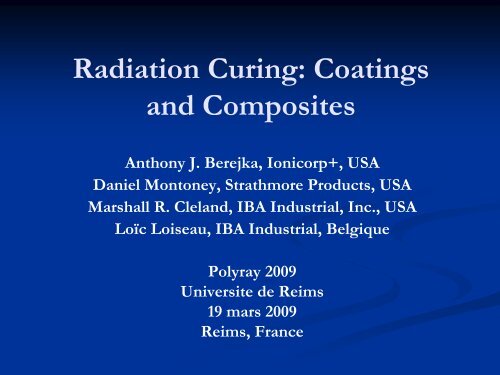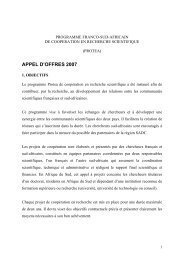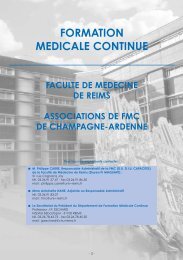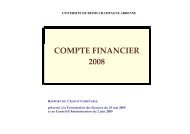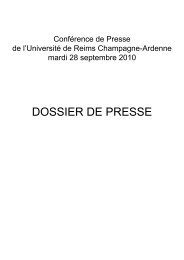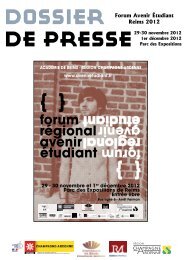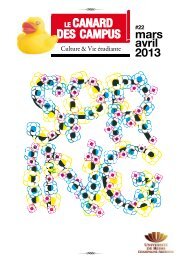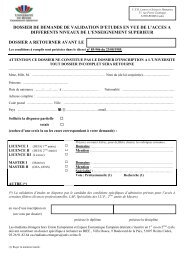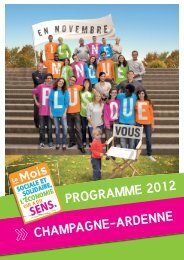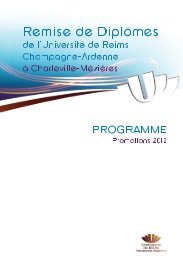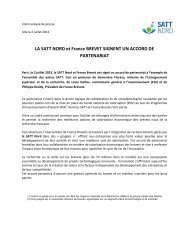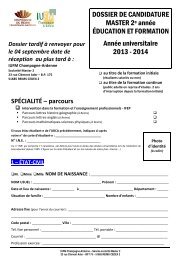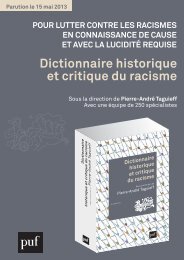Radiation Curing: Coatings and Composites
Radiation Curing: Coatings and Composites
Radiation Curing: Coatings and Composites
Create successful ePaper yourself
Turn your PDF publications into a flip-book with our unique Google optimized e-Paper software.
<strong>Radiation</strong> <strong>Curing</strong>: <strong>Coatings</strong><br />
<strong>and</strong> <strong>Composites</strong><br />
Anthony J. Berejka, Ionicorp+, USA<br />
Daniel Montoney, Strathmore Products, USA<br />
Marshall R. Clel<strong>and</strong>, IBA Industrial, Inc., USA<br />
Loïc Loiseau, IBA Industrial, Belgique<br />
Polyray 2009<br />
Universite de Reims<br />
19 mars 2009<br />
Reims, France
Industrial Electron Beam Markets<br />
WIRE<br />
CABLE<br />
TUBING<br />
SURFACE<br />
CURING<br />
SERVICE<br />
OTHER<br />
TIRES<br />
SHRINK<br />
FILM<br />
>1400 high current EB manufacturing installations
Electron Beam Parameters<br />
Voltage = Electron Penetration<br />
= Thickness Penetrated<br />
Amperage = Beam Current<br />
= Exposure Intensity<br />
Kilowatts = Megavolts x Milliamps<br />
kW = MV x mA
EB Market Segments<br />
Require Different Energies<br />
Market<br />
Segment<br />
Surface <strong>Curing</strong><br />
Shrink Film<br />
Wire & Cable<br />
Sterilization<br />
<strong>Composites</strong><br />
Electron<br />
Energy<br />
80 – 300 keV<br />
300 – 800 keV<br />
0.4 – 3 MeV<br />
3 –10 MeV<br />
10 MeV<br />
Typical<br />
Penetration<br />
0.4 mm<br />
2 mm<br />
11 mm<br />
38 mm<br />
24 mm
80 - 120 keV Development Unit<br />
1.5 m<br />
0.9 m<br />
1.5 m
Low-voltage EB Pilot Line<br />
300 keV self-shielded EB unit for<br />
crosslinking film or surface curing
Low-voltage EB Equipment<br />
300 keV self-shielded EB unit for<br />
crosslinking film or surface curing
Industrial Electron Beams<br />
2.7m<br />
1.6m<br />
6.6m<br />
3.0m<br />
10 MeV, 200 kW<br />
5 MeV, 300 kW
X-ray Conversion
X-ray Depth of Penetration<br />
80<br />
Dose (kGy)<br />
60<br />
40<br />
20<br />
0<br />
0 10 20 30 40 50<br />
Depth in cm x density, g/cc<br />
10 MeV electrons 5 MeV X-Rays 7.5 MeV X-Rays
Unipolis 10 MeV EB/X-ray Facility
RDI Studies – late 1960s<br />
Walter Brenner <strong>and</strong> Marsh Clel<strong>and</strong><br />
5 July 2005
Brenner-Campbell Conclusions
Surface Tension Tests<br />
Control of water =<br />
high contact angle<br />
EB formulation =<br />
low contact angle
Surface Tension Tests<br />
55<br />
Contact Angle<br />
50<br />
45<br />
40<br />
35<br />
30<br />
33 34 35 36 37 38 39<br />
Surface Tension, dynes<br />
EB curable coating binders
VARTM with HDPE Platens<br />
Carbon fiber twill sealed in between platens
VARTM with PC/HDPE Platens<br />
Wetted carbon<br />
fiber<br />
Carbon fiber twill sealed in between platens
EB/X-ray Cured Sample
Solubility EB/X-ray Cured Samples<br />
Gel content, %<br />
100<br />
80<br />
60<br />
40<br />
20<br />
0<br />
X-ray cured<br />
EB cured<br />
~2g resin sample immersed<br />
in methylene chloride<br />
for ~16 hours<br />
0 10 20 30 40 50 60<br />
Dose, kGy
EB Coating Flexibility<br />
M<strong>and</strong>rel Bend<br />
0-T Bend
Toughness Testing<br />
123 cm<br />
Falling tup impact testing:<br />
Eight ply carbon fiber composite<br />
matrix with impact additive
Toughness/Impact Testing<br />
Four ply carbon fiber composite <strong>and</strong> aluminum test panel of<br />
comparable thickness: impacted at 13.6 N-m
Properties Six Ply Carbon<br />
Fiber Reinforced <strong>Composites</strong><br />
X-ray cured Initial fracture Izod<br />
in mold at 24 kGy of matrix Impact<br />
bis-phenol-A diacrylate 6.8 N-m 901 J/m<br />
matrix system – no impact additive<br />
bis-phenol-A diacrylate 15.8 N-m 1043 J/m<br />
matrix system – with impact additive
Developing Molecular Structures<br />
Molecular weight, Mn, <strong>and</strong> molecular<br />
weight between crosslinks, Mc, is important
Developing Molecular Structures<br />
Conventional bis-phenol-A diacrylate<br />
Multiple suppliers, used in radiation curable coatings
Microphase Underst<strong>and</strong>ing<br />
Intra-molecular<br />
impact additive<br />
Inter-molecular<br />
impact additive
Microphase Underst<strong>and</strong>ing<br />
Intra-molecular<br />
impact additive<br />
Inter-molecular<br />
impact additive<br />
SEM to same µm scale
Microphase Underst<strong>and</strong>ing<br />
SEM µm scale<br />
amine cured epoxy<br />
AFM nano scale gel<br />
UV cured epoxy diacrylate
Thermal Analysis Resin Systems<br />
X-ray cured at 20 kGy<br />
DSC Tg TMA Tg<br />
bis-phenol-A diacrylate 54°C 66°C<br />
(Mn = 452)<br />
ethoxylated b-p-A diacrylate ---- 67°C<br />
(Mn = 572)<br />
diluted acrylated epoxy-phenolic 92°C 69°C
Dynamic Mechanical Analysis
Dynamic Mechanical Analysis<br />
Used by Charlesby for EB cured styrene-polyesters
Dynamic Mechanical Analysis<br />
75<br />
Peak tan δ, °C<br />
70<br />
65<br />
60<br />
55<br />
0 10 20 30 40 50 60<br />
Effect of X-ray dose on peak tan δ<br />
on coating binder/matrix materials
Dynamic Mechanical Analysis<br />
tan δ<br />
42°C<br />
Binder/matrix X-ray cured in mold to 60 kGy
Dynamic Mechanical Analysis<br />
tan δ<br />
34°C<br />
Eight ply carbon fiber X-ray cured in mold to 20 kGy
Pragmatic Tests: TMA<br />
TMA in compression mode
EB XL PE Creep Resistance<br />
Deformation, mm<br />
(TMA constant load at >T m)<br />
0<br />
0.1<br />
0.2<br />
0.3<br />
0.4<br />
0.5<br />
0.6<br />
0 200 400 600<br />
Time, seconds<br />
EVA Tm = 72°C under constant load at 100°C<br />
200 kGy<br />
150 kGy<br />
100 kGy<br />
50 kGy<br />
15 kGy
Heat Deflection Test<br />
1.82 MPa<br />
100 mm<br />
13 mm<br />
Temperature increased a 2°C/minute under constant load
Heat Deflection Test<br />
Six ply composite X-ray Heat<br />
cured in mold at 24 kGy Deflection<br />
bis-phenol-A diacrylate >180°C<br />
matrix system – no impact additive<br />
bis-phenol-A diacrylate >180°C<br />
matrix system – with impact additive<br />
Test ended at 180°C = maximum temperature of heating bath
X-ray <strong>Curing</strong> Studies<br />
Initial X-ray curing carbon fiber composite in the mold
Deep-drawn Fiber Composite
X-ray <strong>Curing</strong> <strong>Composites</strong> in the Mold
X-ray Cured Motorcycle Fender
X-ray Cured Sports Car Fender
Conclusions<br />
+ Materials development intended for coatings<br />
work can be transformed into use as the<br />
matrix system for fiber reinforced composites<br />
+ Tests conducted using low-energy EB can be<br />
scaled up to higher energy <strong>and</strong> X-ray curing<br />
+ X-rays facilitate curing in the mold which can<br />
be used for large sized products
Conclusions<br />
+ Some properties developed for coatings are of<br />
benefit when binders are used as matrices:<br />
Surface wetting = adhesion<br />
Flexibility = impact resistance<br />
+ Binders <strong>and</strong> matrices for EB/X-ray curing<br />
should be intentionally designed polymers<br />
+ Fundamental insights into materials should<br />
be tempered with pragmatic testing


